|
Music Is The Healing Force Of The Universe The Inconsistency of |
|
|
||||||||||||||||
|
April 1 2024
New York Eye And Ear Control As I’ve said before, on numerous occasions, I don’t know anything about how music works. To me it is just magic. Luckily for you this site does include some serious Ayler musical information, provided by various people, whom I shall remember in my will. One of these people is Sean Wilkie, who has already provided in-depth analyses of the Slugs’ Saloon and the La Cave sessions and this month sent me his breakdown of the New York Eye And Ear Control session. Although this is accessible in the Music section of the site (on the Albert Ayler and the Inconsistency of Tune Titles page), I thought I worth including it here as well, if only to prove that there’s more to this site than the daft stuff I usually just contribute.
NEW YORK EAR AND EYE CONTROL by Sean Wilkie Is New York Ear And Eye Control an Albert Ayler album or is it just an album that he plays upon? Is it a sui generis product of collective improvisation by a one-off sextet of musicians? Or – recorded only one week later, with the same trio, albeit this time augmented by three additional horn players – should it be considered the follow-up to Spiritual Unity? I was prompted to consider this by something Patrick Regan said, in correspondence with me: “Although we all treat it as an Ayler album (much like Sonny's Time Now), it was meant to be a collective effort.” [11/9/2022]. I replied: “I was inclined to respond by saying: although it’s purported to be a collective effort, we all correctly treat it as an Ayler album (by the Albert Ayler Trio + 3).” [18/10/2022]. And although this response was partly tongue-in-cheek, it was also informed by how I’d come to hear A.Y., following some careful listening I had devoted to it. I hadn’t yet listened so intensively to I.T.T.. A few months later, I read Richard Koloda’s excellent book, Holy Ghost. I was, by then, aware that I.T.T. and Don’s Dawn – but not A.Y. – were used in Michael Snow’s film, and I had listened closely to I.T.T., as well. I was intrigued to find that the book’s discussion of New York Ear And Eye Control (henceforth, NYEAEC), pertained to my question. While acknowledging that the musicians intended to create something of this sort, Koloda concludes that NYEAEC isn’t a “true collective free improvisation” (p.101), such as the film’s director, Michael Snow, recalled requesting of Ayler: “I wanted it to be as much ensemble improvisation as could be with no solos” (from Jason Weiss, Always in Trouble; quoted in Holy Ghost (HG), p.99). Koloda thinks that, in this respect, the endeavour failed. “Despite the group’s intentions, New York Ear And Eye Control is not a true collective free improvisation, since Ayler’s playing dominates while the other five musicians follow him” (HG, p.101). Koloda’s suggestion - that it was by the force of his musical personality that Albert Ayler led the music made by the group – is echoed by Roswell Rudd: “It was just the force of his thrust. He had such a strong sense of purpose that the music kind of gravitated toward him.” (Weiss, quoted in HG, p.101). In the same passage, Rudd elaborates, thus: “playing an accompaniment to him was like playing in a Dixieland band to me, with a strong trumpet player or something. It was kind of a natural, reflex action that happened.” (ibid.) But the film’s director, Michael Snow, took a different view. He thought that the music recorded by the sextet closely reflected what he wanted and had requested explicitly from them: that there should be no themes, with as much “ensemble improvisation” and as little individual ‘soloing’ as possible. “They [the NYEAEC musicians] all used to play ‘heads,’ you know, a tune of some kind, and then a solo, and then ‘head’ again, and I found myself disagreeing with that. When I had them come to the studio to record the soundtrack, I was careful to tell them that I didn't want any themes, but as much as possible ensemble playing. They accepted and they performed this way, but, in my opinion, this is one reason for which the music is so great. I mean, they're great, fantastic musicians, but they were stuck in that business of the statement of theme, alternating with solos.” (Snow, interviewed by Athina Rachel Tsangari, Austin Chronicle, 17 Sept. 1999) I suggest that this statement explains why Snow chose I.T.T., rather than A.Y., to soundtrack his film. A.Y. too closely embodies the sort of musical structure which Snow disparages. I.T.T., far less so. The music on the NYEAEC album is far more organised and arranged than it has typically been acknowledged. A.Y., for example, can be analysed as having a loosely thematic opening section, extending from the opening notes to around 4.26. I break this down into (a) an introduction, (b) a saxophone melody, (c) a Vibrations-like melody, and (d) a transitional passage; details are provided, below. Then, there are solos: by Cherry, then Ayler, and then Rudd. Due to the greater involvement of the other horn players, Ayler’s solo contrasts with those by Rudd and by Cherry; but if it is collective improvisation, rather than a solo, then it is susceptible to Koloda’s and Rudd’s views about Ayler’s tendency to assume the lead. Following Rudd’s solo, there is a minute-long section, akin to a closing theme, which brings the music to a stop, at 11.23. I can only speculate on whether the musicians actually stopped playing, or whether they only silenced their instruments briefly, before Cherry plays the motif, first heard from Tchicai, over the end of Rudd’s solo and the beginning of the ‘closing theme’. Whether the temporal continuity is affected or real, I regard the second half of A.Y. as commencing with Cherry’s couplets. After a short passage in which Cherry, aided principally by Gary Peacock, develops this ‘couplets motif’, Tchicai reclaims the motif, at 12.18. He is soon joined by Ayler, who dominates the final eight minutes of the performance. The other horn players participate: it is less of a conventional solo, or feature, than is Roswell Rudd’s ‘spot’ or either of Don Cherry’s. But, like Ayler’s ‘solo’ in the first half of the piece, this, if it is a collective improvisation, is nevertheless dominated by Ayler’s playing. In that sense, I find parallels with what we might regard as the collective improvisation embodied by the music of the trio of Ayler, Peacock and Murray, as heard on both Prophecy and on Spiritual Unity. And these dispose me to consider A.Y. to be, in effect, a performance by the Albert Ayler Trio (+ 3). Before I discuss I.T.T., and the ways in which I think it differs from A.Y., I shall briefly signpost some aspects of the arrangements that I hear in A.Y., principally in its first half. The horn players anticipate the melody or theme that Albert Ayler and John Tchicai play together at 0.47, having dropped out beforehand in preparation. The rhythm section, to my ears, react to these phrases as though they were expecting them. There is a second theme, reminiscent of Vibrations, which is heard first at 1.50 and again at 2.47. When Ayler improvises around these statements, his interplay with Gary Peacock is reminiscent of their collaborations in the Spiritual Unity trio. What Tchicai plays, at 3.41, is immediately paraphrased by Ayler and, although it might be spontaneous, this brief passage signals the end of the theme section and the transition to passages dominated by individual soloing: Don Cherry is featured from 4.18 to 5.46, Albert Ayler, from 6.02 to 9.06; Roswell Rudd, from 9.13 to 10.34. The couplets played by Tchicai, at 10.29, both signal a closing ‘theme’, featuring long tones played predominantly by Cherry and Ayler, from 10.34 to 11.24, and also provide the ‘thematic’ basis for the second half of this piece, led off by Don Cherry, at 11.24. Following Cherry’s short introduction to the second half, the couplets-motif passes back to Tchicai. Ayler briefly references this motif, before developing his own ideas in the foreground. I have divided this second half of A.Y., by referencing some melodies which Ayler plays. I would draw attention to certain similarities between the second half of A.Y. and the original recording of Holy Holy, from February 1964. On the earlier piece, melodies such as Hickory-Dickory-Dock (2.13 – 2.25) and Ayler’s own Ghosts (2.41 – 2.49; 4.47 – 5.06) are heard during the course of his improvisation; amongst laughter (3.22 – 3.32), repeated bugle- or hunting-calls (3.33 – 3.42), and modern jazz (3.59 – 4.25). The last eight minutes of A.Y feel like a similar journey, culminating with a melody, at 19.07, that may be spontaneous, but has a considered manner to which all the other musicians contribute. Despite the feeling of resolution and culmination that pervades the final minute of this recording, the abruptness of the ending, on a bowed-tone from Gary Peacock, suggests a very-swift fade. I have elsewhere written a lengthier description of A.Y., but the following summary should indicate those structural aspects, which I have described here. A.Y. Part One 1. (0.00 – 4.26) Head / Themes. a. (0.00 – 0.46) Introduction. Horns drop out, anticipating the melody at 0.47. b. (0.47 – 1.49) Saxophone melody, with Vibrations-like response phrase at 0.59. c. (1.50 – 3.40) Vibrations melody, repeated at 2.47. d. (3.40 - 4.26) Scampering staccato transition, Tchicai initiates this, but is soon joined by the others. Ayler briefly erupts. Cherry commences his solo at 4.18. 2. (4.18 – 10.34) Solos. a. (4.18 – 5.46) Cherry-led brass section. Ayler drops out at 4.26, JT is also silent until 5.47. b. (5.47 – 9.12) Ayler’s Y. Tchicai initiates this, repeating a phrase (5.47 – 6.19). Ayler enters at 6.02 and dominates thereafter. Intensity drops around 8.55. Ayler signs off, 9.00 – 9.06. c. (9.13 – 10.34) Roswell Rudd Incident. Briefly, a duet of Peacock and Rudd, although Murray plays cymbals with restraint. Peacock and Murray shine here, in support of Rudd. Tchicai’s entrance at 10.29, with a couplets motif, signals the ‘out-head’ that follows. 3. (10.34 – 11.23) Long-notes closing theme / head. Cherry and Ayler are most prominent in this. Tchicai continues to play the couplets motif, until around 10.57. (Is there an engineered fading of the volume at the end of this section?) Part Two 4. (11.24 – 12.18) Cherry’s couplets. Cherry leads off, with the couplets motif from 10.29 – 10.57. 5. (12.18 – 19.06) Saxophone couplets / Albert’s merry melodies a. (12.18 – 15.11) Couplets and gutbuckets. Tchicai picks up the motif, repeating the couplets. Ayler toys with this motif, 12.31 – 12.55, but moves into some ferocious improvisation, with Tchicai providing some ‘counterpoint’, 14.16 – 14.22, and again at 14.42. b. (15.11 – 17.39) Tuppeny Rice and Repetition. A favourite Ayler melody. Repeated patterns from both Tchicai, 15.17 – 16.18 and Ayler, 15.54 – 16.11 and 16.16 – 16.26. Ayler ruminates as the intensity lessens, allowing Cherry’s reflections to be heard. c. (17.40 – 19.06) Albert’s Upward Melody. The upwards line is followed by some trademark Ayler staccato blowing. When Ayler drops out, 18.10 – 18.48, Cherry takes the lead. d. (19.07 – 20.14) Closing melody / head. This could be numbered separately but, equally, it is the last of Ayler’s merry melodies. Ayler leads, with a melody that’s slightly reminiscent of What Is This Thing Called Love? And, perhaps, also Mothers. Cherry responds.
By contrast, I.T.T. has far less audible structure and far fewer signs of pre-planned arrangement. The melody of Ayler’s composition, Holy, Holy is commonly acknowledged to commence I.T.T. Koloda underplays its presence, calling it a “short quote [from the melody] … that acts as a trigger” (Holy Ghost, p.103). To my mind, this fails to acknowledge that there is no more to the melody of Holy, Holy, in its original recording, than what we hear on I.T.T. Despite beginning with, not just a ‘head’, but a previously played composition, I.T.T. better fits Michael Snow’s view of the music, partly because there are no obvious solos, such as those by Cherry and Rudd on A.Y. Moreover, in my opinion, Ayler does not dominate this performance to anything like the extent that he does on A.Y. The following analysis presents it as an episodic sequence.
I.T.T. 1. (0.00 – 3.27) Head / Themes a. (0.00 – 0.53) Holy, Holy. Thematic phrase three times, from 0.00 to 0.08. Reprised by Ayler, from 0.16 to 0.24. Rudd echoes the second half of the thematic phrase, three times, from 0.28 to 0.34. b. (0.53 – 3.27) Second theme. Over the same texture, a descending melody of eight notes from Tchicai, played twice. (It sounds as though he has moved close to the mic.) Peacock plays a recurrent bass tone, which appears to be derived from the Holy, Holy melody. 2. (3.27 – 5.38) Relative Sparsity. The intensity of the opening has waned. Tchicai is foregrounded, from 3.43, with support from first Rudd, then Cherry too. Ayler rejoins them at 4.54. 3. (5.38 – 7.57) Stormy. Ayler begins a stuttering sequence of staccato notes, building in intensity, which morph into longer, unbroken lines at 5.59. At 6.55, there is a lively collective section. Ayler makes his presence felt from 7.30 with some foghorn-like blasts. From 7.43, it calms down again. 4. (7.57 – 11.29) Calls and responses. Some powerful melodic lines from Ayler, 8.03 – 8.27. What Tchicai then plays, following Rudd, seems to influence what Ayler plays at 9.13. At 10.13, Rudd plays the title-phrase of Three Blind Mice. Ayler makes a distinctive contribution, 10.56 –11.10, to which Tchicai responds. There is a brief lull, before the following. 5. (11.29 – 13.23) Tchicai’s new melody. A slightly boppish, thematic melody from JT. AA joins, playing a similar line, neither in unison, nor in obvious counterpoint. The intensity builds as all contribute. 6. (13.23 – 14.25) Albert’s Cha-Cha. A new melody from Ayler, 13.23 – 13.33, repeated and then modulated. From 13.41, Tchicai and Cherry play a supporting two-note phrase, echoing the opening notes of the melody. It continues through this short section, during which the intensity diminishes. 7. (14.26 – 17.52) More but less, less but more. A calmer, reflective mood dominates. The two-note supporting phrase continues. There’s a hint of Ghosts, 15.14 – 15.22, in Ayler’s improvising, which is intense without dominating. 8. (17.52 – 20.54) Albert’s sermon. Another familiar melody from Ayler, which may be a variation on Half-a-pound-of-tuppeny-rice. The keening ‘A-men’ cry which ends this sermon, 18.20 – 18.22, is echoed by Cherry and marked by two drum rolls from Murray, 18.27 – 18.31. 9. (20.54 – 22.06) Albert’s staccato finale. Ayler plays staccato, 20.54 - 21.34. Longer tones from this point lower the intensity. Final thoughts from all. * New York Ear and Eye Control In the following descriptions of the two long pieces of music from the album, the musicians are designated by their initials. All references to timings are approximate. A.Y. (20.17) 00.00 – 00.47 1a. Intro (0.47) AA leads off, all soon join him in a fast, busy rhythm. JT repeats triplets, 0.22 - 0.34; towards the end of these, AA makes two explosive interjections, 0.31 – 0.36; after which, AA isn’t heard until the first theme/melody at 0.47. What follows, sounds to me arranged. The other horns also drop out, by 0.45, preparing for the short saxophone melody/theme that’s coming. GP and SM keep the busy rhythm going, to 0.47, but the way they respond to the saxophones at 0.47, suggests that they, too, were expecting something like this. 00.47 – 01.49 1b. Saxophone melody (1.02) There’s a lot of counterpoint between JT and AA here. JT playing a lot more notes than AA. There’s a superficial similarity between the opening melodic phrase of Angels (the tune recorded at Hilversum in 1964; not the one Ayler recorded with Call Cobbs) and what AA plays here. JT plays ahead of and over AA on this theme; AA’s line has only seven notes, prior to his stuttering Vibrations-like response-phrase at 0.59 (after which, DC quotes We’re In The Money, at 1.01.) 01.50 – 03.40 1c. Ayler’s Vibrations melody (1.50) A Vibrations-like melody from AA, overblowing ca. 2.03/2.06. JT boppish, others wail; a reprise of this theme ca. 2.47, AA with its response-phrase ca. 2.58. AA leads after that, GP shadows him responsively. 03.41 – 04.18 1d. Staccato scamper transition (.37) JT begins, all swiftly join, a swirly end, AA erupts. 04.18 – 05.46 2a. Cherry-led Brass section (1.28) SM roll to 4.26 may better mark the end of the previous: it is also where AA drops out. (For the rest of this section, neither AA nor JT are heard.) Equally, DC departs from the sax-dominated staccato line – commencing his ‘solo’ - as early as 4.14. RR tag-team support at 5.12, DC returns mirroring RR’s part. [cf. DC on Vibrations, Copenhagen 10/9/64, 2.40 – 3.25]. 05.47 – 09.12 2b. Ayler’s Y (3.25) This section is dominated by AA, but it starts with JT, repeating a phrase to 6.19; AA enters at 6.02; a ‘break-down’ of the momentum or lessening of intensity to 6.47; AA improvising alone, over a fast tempo, to 7.13, where the other horns join in; AA hammer drills to the top ca. 7.38/7.48, staccato ca. 8.02 /8.11, ending w/ nice phrase; then another all-horns-pile-in, but AA wailing hardest by a length. While AA plays with such intensity, both DC and JT raise their own levels too, contributing to a wall of sound effect. There is a lessening of both tempo and intensity, ca. 8.55, which AA acknowledges with a two-part delicate sign-off phrase, 9.00 – 9.06. RR is heard from 9.07 but DC’s final statement here 9.09 - 9.10 is more prominent than RR, and SM has a final roll 9.10 – 9.12. 09.13 – 10.34 2c. Roswell Rudd Incident (1.21) It is very briefly a duet of GP & RR, although SM is quietly playing cymbals for these few seconds. It soon becomes trio music of a high order, GP and SM playing here with all the subtlety and responsiveness they display on Spiritual Unity. JT enters, playing little couplets, from 10.29. This seems to signal what follows. 10.34 – 11.24 3. Group long-note melody (.50) An arrangement again sounds apparent. DC leads off the long-notes, joined by AA. JT persists with the couplets. Squiggles from RR. Ends with brief pause. Is the volume faded down at 11.23? 11.24 – 12.18 4. Cherry’s couplets (.54) with no definitive evidence of a tape cut, DC leads off the second half of AY with little couplets, similar to those, by JT, that ended the RR Incident section. Joined by GP and SM’s cymbals, DC persists with these couplets. 12.18 – 15.11 5a. Couplets and Gutbuckets (2.53) JT picks up the couplet motifs; AA too, flirts with this motif, from 12.31. While JT repeats it, AA plays with it, gradually developing his own ideas. AA leaves the couplet motif ca. 12.56, overblows at 13.18 as if annoyed by JT’s repeat flurries ca. 13.12/13.20; AA’s paint-stripping blasts (13.18 – 13.44) convene a frenetic “all-pile-in”. JT (?) makes high-register congregation calls, ca. 14.16/14.22, w/ call-back at 14.42. AA plays gnarly phrases, 14.22 – 14.32. The intensity peaks at 15.06, with a drum roll by SM, but it continues at a high level, into the following section. 15.12 – 17.40 5b. Tuppenny Rice and Repetition (2.28) Half-a-Pound of Tuppenny Rice Melody: C#-F#-G#-A#-B-A#-G#-F#. Repeats: from JT 15.17 to 16.18; AA 15.54 to 16.11 and 16.16 to 16.26. By 16.30, the intensity is fading, reminders from AA at 16.50, 16.55; slows to 17.11, DC obbligato. 17.41 – 19.06 5c. Albert’s Upwards Melody (1.26) CCC-FF-G-A-highC. AA leads, inviting response from whoever. Other horns from 18.10, AA drops out, DC leads. AA rejoins at 18.48 19.07 – 20.14 5d. Closing melody (1.07) By AA, cf. What Is This Thing Called Love?, or Mothers. with DC’s bird-call responses.
ITT (22.08) 0.00 – 0.53 1a. Holy Holy melody (0.53) Thematic phrase three times, from 0.00 to 0.08, played by AA, with GP and SM in rhythmic support, and DC, JT and RR sparingly commenting. A call and response follows, with DC responding to AA, before the Holy Holy melody is reprised, by AA alone, from 0.16 to 0.24. DC begins to play with greater abandon over this reprise of the melody, and he is soon joined by RR, JT and AA. RR echoes the second half of the thematic phrase three times, from 0.28 to 0.34. It now develops in a collective, free direction. On a superficial level at least, what each musician plays sounds independent of his colleagues. In my opinion, the music is actually quite organised in these opening minutes, with the horn players leaving space for each other, and creating a mosaic of overlapping phrases, lines, flutters and blarts. There is no significant change in the music at 0.53. 0.53 – 3.27 1b. Second theme (2.33) Over this same texture, a descending melody of eight notes from JT, played twice. (It sounds as though he has moved close to the mic.) He extrapolates upon this idea until 1.46; meanwhile AA, DC and RR continue to improvise freely, without obvious connections to each other’s playing. GP offers a recurrent tonic bass pedal, the same tone as the ending of Holy Holy’s thematic phrase. Three keening cries from JT at 2.33 – 2.41. Following this, some eruptions from AA, 2.41 – 3.01, with JT and SM joining him at the end, 3.01 – 3.20. After this, the intensity begins to wane. 3.27 – 5.38 2. Relative Sparsity (2.11). Saxes have dropped out. RR plays a four-note phrase, capped with a boppish twist. AA plays a little bit, in the background, 3.41 – 3.52. JT is again foregrounded, from 3.43 onwards, with sympathetic support, initially from RR, and then from DC as well. AA rejoins them, ca. 4.54 onwards. Flurries from AA from 5.15, accompanied by drum rolls from SM, foreshadow the next developments. 5.38 – 7.57 3. Stormy (2.19) At 5.38, AA begins a stuttering sequence of staccato notes, building in intensity. This morphs into longer, unbroken lines at 5.59. AA moves off-mic at 6.07, but everybody else sounds energised by his contribution. AA plays high and ghostly from 6.27 to 6.46, then drops into a lower, guttural register. From 6.55 there is a lively collective section, in which everybody is saying what they want to, with little regard for what anybody else is (saying), while respectfully leaving space for these other opinions. AA makes his presence felt from 7.30 with some foghorn-like blasts. From 7.43, it calms down again. 7.57 – 10.08 4a. Calls and responses (2.11) A couple of fluttering wails from AA presage some typically powerful melodic lines from him, 8.03 – 8.27. Here AA provides his own call-and-response patterns, but RR plays his own response at 8.27, and he is followed immediately by JT, who develops these ideas. AA rejoins at 8.56, with what first sound like new and different ideas: however, by 9.13, perhaps influenced by DC, he echoes the lines played earlier by JT. SM subtly builds the intensity. The mood continues into the next section. 10.08 – 11.29 4b. More calls and responses (1.20) A loud blart from AA is shortly echoed by RR at 10.13, perhaps playing the title phrase of Three Blind Mice. Following some busy collectivity, with repetitive figures from JT, there is a distinctive contribution from AA, 10.56 – 11.10, with JT providing a response. A brief lull presages the following section. 11.29 – 13.23 5. Tchicai’s new melody (1.55) A slightly boppish, thematic melody from JT. AA joins playing a similar line, neither in unison, nor in obvious counterpoint. This is fragmented, on his fifth pass, by AA, from 11.48, against a chaotic background. This strikes me as more ‘all-in’ than the mutual respect I heard in the earlier sections. AA plays furiously, but he doesn’t appear to deter anybody else. 13.23 – 14.25 6. Albert’s Cha-Cha (1.02). Another new melody from AA, 13.23 – 13.33, repeated and then modulated. AA breaks out, and improvises intensely, but moves away from the mic. From 13.41, JT (with DC) plays a supporting two-note phrase, which echoing the opening notes of AA’s melody, and continues throughout this short section, during which the intensity diminishes. 14.26 – 17.52 7. More but less, less but more (3.25) A short phrase by RR is echoed, first by RR himself, and then by AA. A calmer, reflective mood dominates. The supporting phrase continues. GP bows. RR provides embellishments. AA exploits the space for some intense improvising, 15.12 onwards, without dominating the music overall. (A hint of Ghosts, 15.14 – 15.22). DC is evident, from 16.10 onwards. (AA soon makes space near the mic for DC, and they alternate phrases.) A melodic fragment from AA at 16.46 – 16.51. JT plays and repeats a line at 17.08 – 17.13. AA is busy, but further back from the mic. 17.52 – 20.54 8. Albert’s sermon (3.02) Another almost-familiar melody from AA, although it may be a variation on Half-a-pound-of-tuppeny-rice. The keening ‘A-men’ cry which ends this sermon, 18.20 – 18.22, is echoed by DC and marked by two drum rolls from SM, 18.27 – 18.31. A collective free-for-all ensues, loosening up ca. 19.08. GP trades with the horns, particularly DC and RR, from 19.15 to 20.10. The saxophones stir, towards the end of this section. 20.54 – 22.06 9. Albert’s staccato finale (1.12) AA staccato, 20.54 - 21.34. Longer tones from this point lower the intensity. Final thoughts from all. * I think one of the things I mentioned in that initial email correspondence with Sean (apart from the respective failures of Stoke City and Swansea City in the inaptly named Championship) was my wondering whether there was any indication that the three pieces on the album (as well as the two long pieces brilliantly analysed above, there is a brief introductory track by Don Cherry, entitled ‘Don’s Dawn’) were complete takes, or whether there was any sense that more had been recorded but not released. Of course, everyone who took part in the session has now passed on, including Michael Snow, and Paul Haines (in whose house the music was made, and who was probably involved with the recording), so there’s no-one to ask, and presumably the original tape has gone the way of its makers. Unless ESP have it stashed in their, no doubt, capacious vault. Just a thought. Oh, and one last thing from Sean - he reckons that supposed picture of Albert Ayler I posted in February, the one with him in conventional Ayler pose but with a flat cap, is David Murray. * Around the World with Albert Ayler - Eastward Bound Dirk Goedeking gave that title to this month’s selection, starting with: Poland: A surprising similarity between covers can be seen on Instagram. The attached (South African) comment is “I’m seeing double! We were surprised to see two albums with such similar design! As far apart as Albert Ayler’s free Jazz may be from Czesław Niemen’s Prog tinged rock ballads, neither were safe from the nebulous forces of 1960s’ psychedelia design tropes! Although these feel too close to be coincidence, perhaps they had the same graphic designer.” |
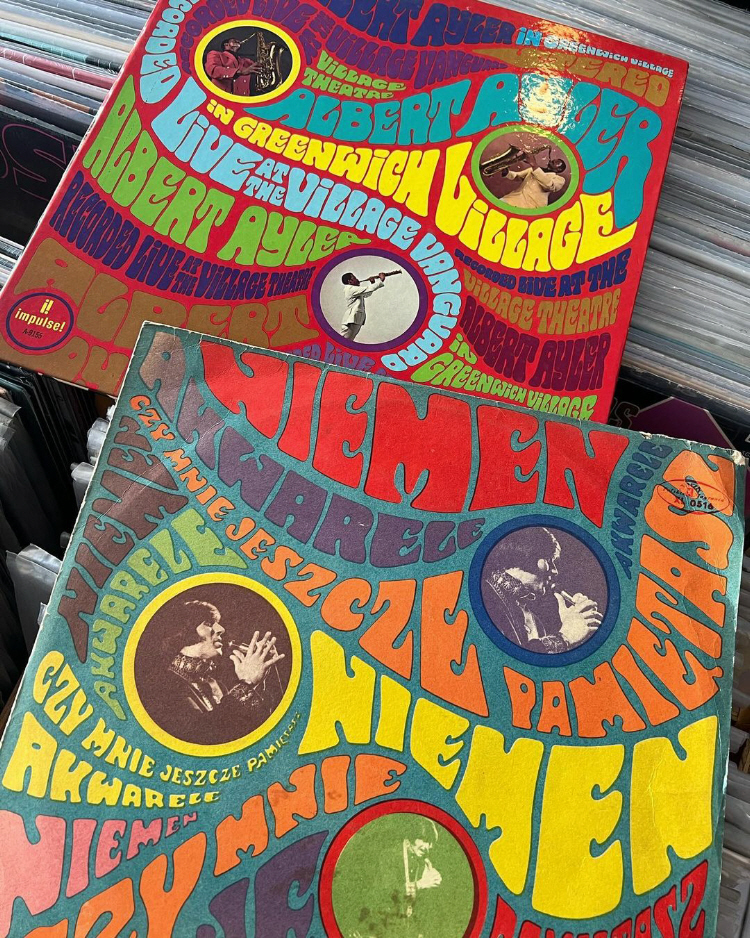 |
|||||||||||||||||||||||||||||||||||||||||||||||
|
Russia: The article "Ayler in Russia" by kcin_kcin can be read in Cyrillic script. If I get it right, the Russia rumour (probably Finland) may be based on the Astrakhan hat Albert brought from Europe. |
|||||||||||||||||||||||||||||||||||||||||||||||
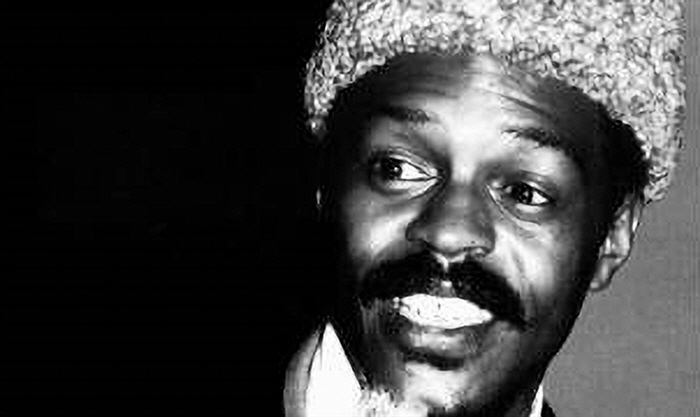 |
|||||||||||||||||||||||||||||||||||||||||||||||
|
As Dirk says, ‘probably Finland’. Comrade Google translated the text as follows: Don Cherry, in a conversation with Ben Sidran (the second volume of the collection Talking Jazz with Ben Sidran (1992)) talks about meeting Albert Ayler in 1963 in Europe and casually mentions an absolutely amazing fact: And he had been in the army and had got out of the army and gone to Russia. Then he came back and was living in Sweden.. Sidran did not react to this in any way and did not clarify the details. Ayler served in the army under contract from September 1958 to September 1961, and during his service in the military band he managed to visit Germany, France, Spain, Sweden and Denmark. In Ayler’s relatively recently published biography, Richard Koloda - Holy Ghost: The Life & Death of Free Jazz Pioneer Albert Ayler (Jawbone, 2022), the fact of visiting Russia, alas, is not mentioned, nor is it mentioned in earlier sources (Jeff Schwartz, Valerie Wilmer , etc.) For lovers of apocrypha, the motivating factor was most likely the “Russian” astrakhan hat that Albert Ayler brought from Europe and wore without taking it off. Perhaps Ayler himself jokingly made up something in response to frequent questions about such exoticism from the wives and girlfriends of friends (for example, Moki, the Swedish wife of Don Cherry, with whom Ayler became close friends in Stockholm). However, the author of the final apocrypha about Ayler after his mysterious death in the chilly waters of the East River was the Ministry of Defense, which paid for his funeral, thanks to whose oversight the inscription was stamped on the musician’s tombstone that US Army Private First Class Albert Ayler ended his life in Vietnam. Although the Astrakhan hat theory is quite neat, I still prefer the other explanation which involves the C. I. A. Ayler was living in Finland in 1962, playing with the Herbert Katz Quintet, around the same time that the Russians were organising the 8th World Festival of Youth and Students for Peace and Friendship in Helsinki at which Archie Shepp, Bill Dixon, Perry Robinson and others played. And the C.I.A. promoted a rival anti-festival event, Young America Presents, which included concerts by Herbie Nichols and Jimmy Giuffre. Jazz wars!!! So I think that’s when the rumours of Ayler visiting Russia began. There’s a lot of stuff online about it all (none of which mentions Albert) including this review by David Grundy and Pierre Crépon of Free Jazz Communism: Archie Shepp–Bill Dixon Quartet at the 8th ___ The journey continues: Vietnam: In the far east you can listen to Albert's music in Hanoi's jazzclub "Long Waits Jazz". And I can interpose this from Japan: We Stand Free: For Albert - Ayler’s Tunes and Improvisations by the Albert Ayler Tribute Unit (Hiromichi Ishiai (ts, ss), Ax Ono (b), Tsuneo Takei (d)) (Ito Music Cultivation Factory (IMCF 0008). Recorded at Studio BEBOP Fukuoka November 6th,.2022. |
|||||||||||||||||||||||||||||||||||||||||||||||
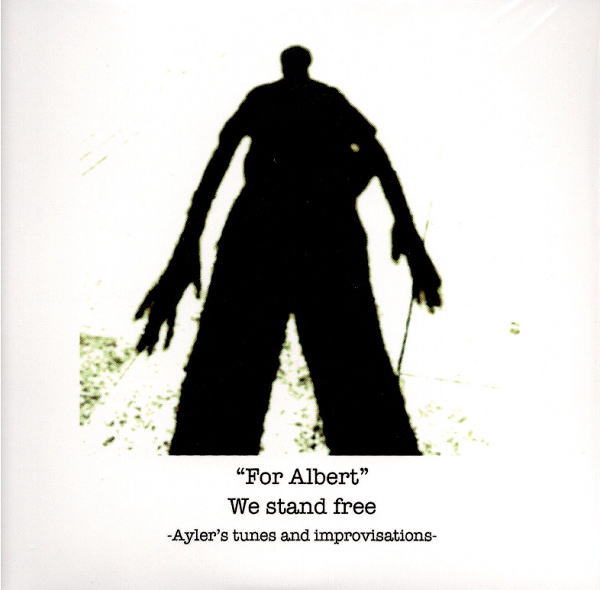 |
|||||||||||||||||||||||||||||||||||||||||||||||
|
Tracks include 'Change Has Come', 'Ghosts', 'Spirits', 'Saints', 'Truth Is Marching In' and 'Our Prayer’.
|
|||||||||||||||||||||||||||||||||||||||||||||||
|
Back to Dirk: USA: Wadada Leo Smith & Amina Claudine Myers will release their new album Central Park’s Mosaics Of Reservoir, Lake, Pathways on 10th May 2024. Track No. 6 is ‘Albert Ayler - A Meditation In Light’ (06:30). |
|||||||||||||||||||||||||||||||||||||||||||||||
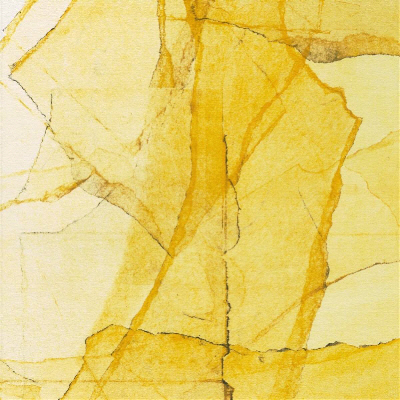 |
|||||||||||||||||||||||||||||||||||||||||||||||
|
Youtube roundup Two versions of ‘Ghosts’, one by Mamaleek, the other by bassist Roberto del Piano. And this:
|
|||||||||||||||||||||||||||||||||||||||||||||||
|
What’s New January to March 2024 has been sent to the vaults. *** May 1 2024
Sean Wilkie Just a follow-up to last month’s marathon dissection of New York Eye And Ear Control by Sean Wilkie to let you know Sean has a gig lined up this month: ‘The New RedOrDead Midweek Five-a-siders vs. What's Left Of The World - will be on Wednesday May 22nd, upstairs at The Flute and Tankard, Windsor Place, Cardiff; with Alex Burch (d) Clem Saynor (b) John Close (g) Nils Kavanaugh (p) Em Craig (as) Coren Sithers (ts,ss) Toby Kearns (tp) and Sean Wilkie (shouting, poetry, stadium announcements, etc.), although we will all be operating under stage-names on the night. Admission £10 / £7 for concessions.’ * The Fondation Maeght is 60 ‘The Fondation Maeght, the first foundation for modern and contemporary art in France, will celebrate its sixtieth anniversary in the summer of 2024. Founded in 1964 by the art dealers, publishers and lithographers Marguerite and Aimé Maeght, it was opened in Saint-Paul-de-Vence by André Malraux. Over 60 years and more than 150 exhibitions by great artists of the 20th and 21st centuries, the Fondation Maeght’s unique perspective has made a strong impression on the history and dissemination of art. The anniversary will be marked by a major summer exhibition, “Bonnard-Matisse, a friendship”, the opening of four new exhibition rooms – dedicated to the permanent collection – and a month of celebrations including conferences, concerts, dance performances, lectures and more. Finally, the Foundation, whose history reminds us that all artistic disciplines are intertwined, is planning a month of celebrations for its sixtieth birthday. These will run from the end of June until the 28th of July, the anniversary of its opening in 1964, which was marked by a memorable concert featuring Ella Fitzgerald and Yves Montand. In 2024, the Fondation Maeght is once again scheduling dance performances, concerts, lectures, conferences, children’s workshops, etc.’ I just wonder if there are any plans to show the documentary film of Albert Ayler’s 1970 concerts at the Fondation Maeght. * Richard Koloda ... ... let me know about a couple of things which may be of interest. First, this photo of Albert Ayler hangs in Cleveland’s Severance Concert Hall. |
|||||||||||||||||||||||||||||||||||||||||||||||
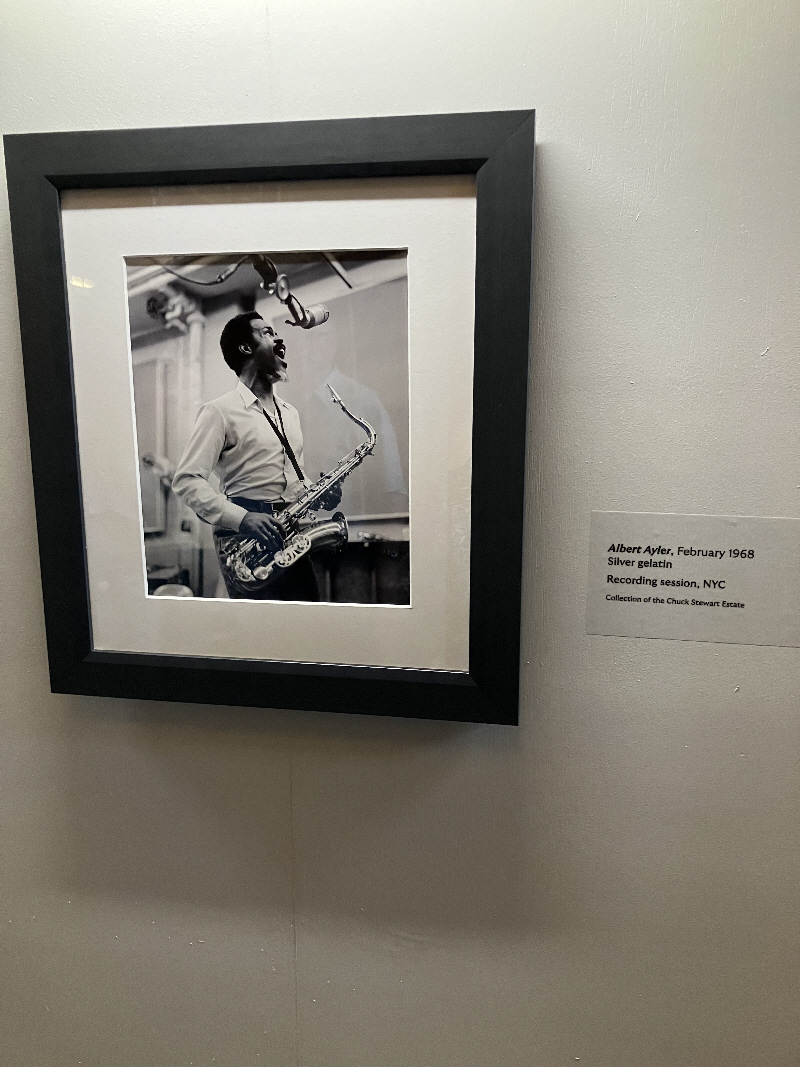 |
|||||||||||||||||||||||||||||||||||||||||||||||
|
Richard writes: ‘Interesting in that Severance Hall is the home of the Cleveland Orchestra. ... I cannot testify as to the significance - was it because Albert was a Clevelander or a musician. I do not know if this was ever seen elsewhere. According to the NY Times obit, Chuck Stewart was a very famous jazz photographer.’ That he was. And Richard followed up with this link to an article on the WOUB site. As for the photograph itself, I have a minuscule copy heading my Photos page. And judging by some other photos, the ‘Recording session, NYC’ of February 1968, was for Love Cry. Richard also let me know about the release of Freedom Weaver: The 1959 European Tour Recordings by Sonny Rollins. ‘Freedom Weaver: The 1959 European Tour Recordings is the first official release of the 'Saxophone Colossus' Sonny Rollins European tour in 1959 with bassist Henry Grimes, and drummers Pete La Roca, Kenny Clarke and Joe Harris. Available previously only as a bootleg release, this is the first official release in cooperation with Sonny Rollins and released as a 3-CD set. Freedom Weaver includes an elaborate booklet with rare photos by Ed van der Elsken, Jean-Pierre Leloir, Bob Parent and many others; lead liners by jazz scholar Bob Blumenthal, and new interviews with Rollins himself, Branford Marsalis, James Carter, Joe Lovano, James Brandon Lewis and Peter Brötzmann. Mastered by the legendary mastering engineer Bernie Grundman.’ Richard added this note: ‘There is a possibility that Ayler saw him while on leave from Orleans.’ It’s another Zev Feldman project (responsible for the 2022 Revelations: The Complete ORTF 1970 Fondation Maeght Recordings) and includes concerts from Sweden, Switzerland, Holland, Germany and France. There’s a review by Marc Myers on Jazz Wax. |
|||||||||||||||||||||||||||||||||||||||||||||||
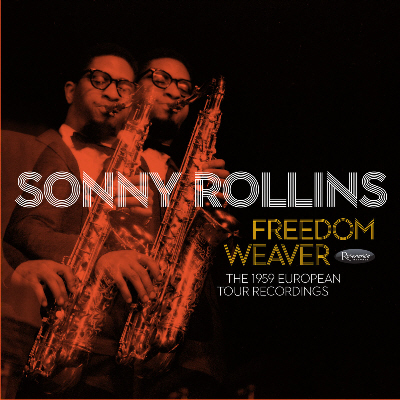 |
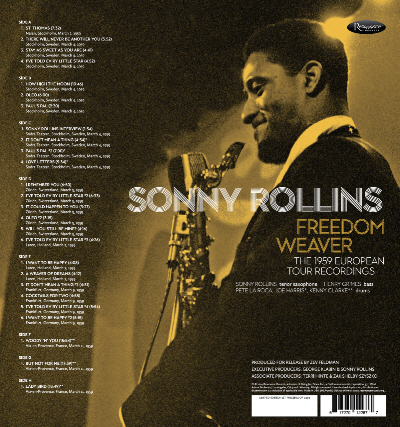 |
||||||||||||||||||||||||||||||||||||||||||||||
|
Some Pictures Dirk Goedeking came across the following Ayler-related artwork, mainly posted on instagram (which, as an old man, I don’t have any dealings with) so it’s tricky separating artist from poster. “- an angelic drawing from Japan 2024, posted by s.toshii. |
|||||||||||||||||||||||||||||||||||||||||||||||
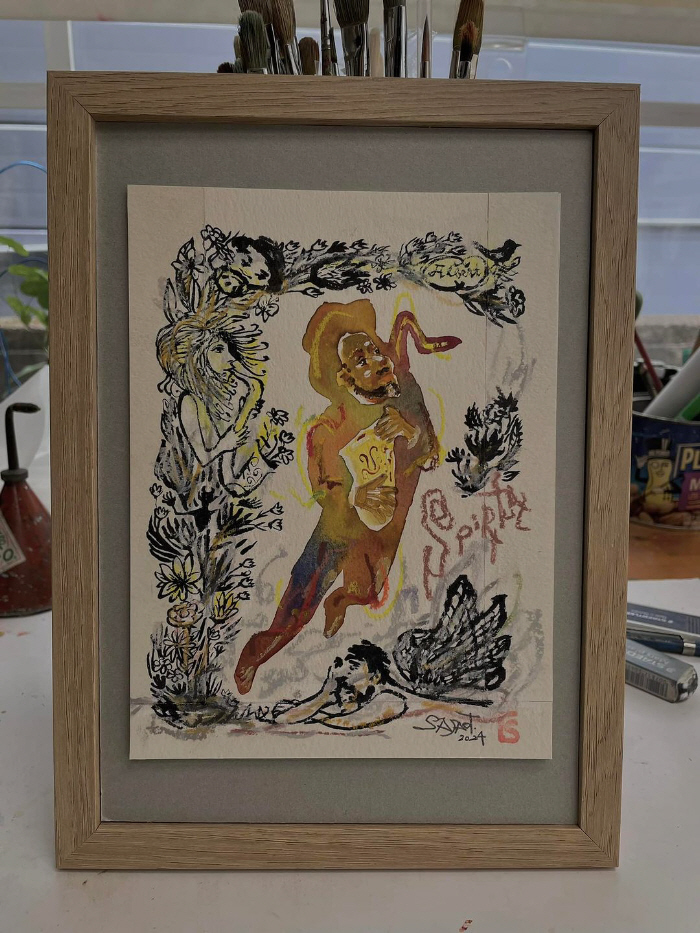 |
|||||||||||||||||||||||||||||||||||||||||||||||
|
“- another tryptichon posted by jascz (paying tribute to Martel Chapman?) |
|||||||||||||||||||||||||||||||||||||||||||||||
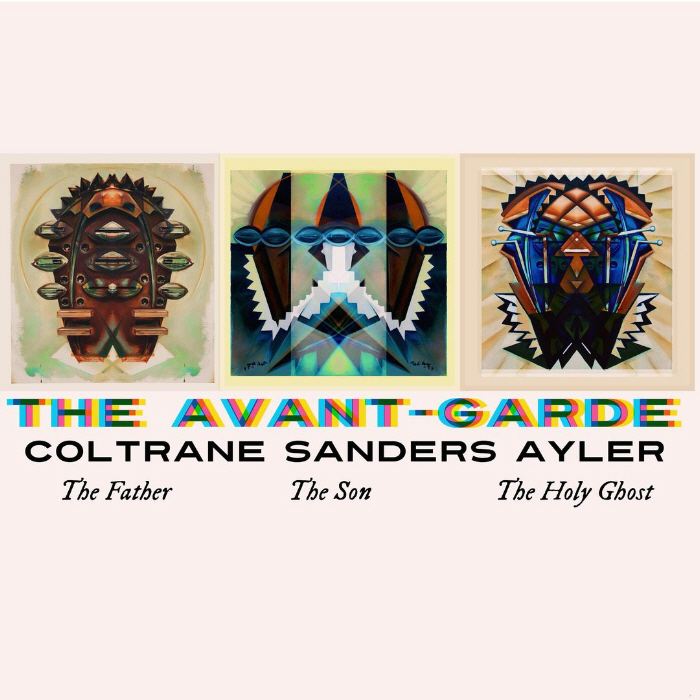 |
|||||||||||||||||||||||||||||||||||||||||||||||
|
“- "My Name Is Albert Ayler" posted by thxblxckgxd, paint on paper cardboard, in different stages. |
|||||||||||||||||||||||||||||||||||||||||||||||
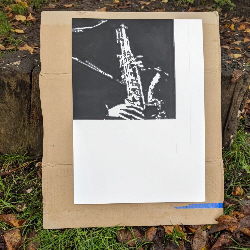 |
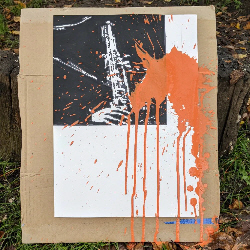 |
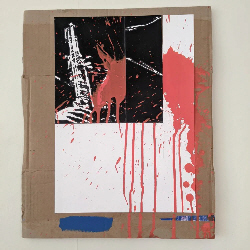 |
|||||||||||||||||||||||||||||||||||||||||||||
|
“- a charcoal portrait posted by randall_chinault. |
|||||||||||||||||||||||||||||||||||||||||||||||
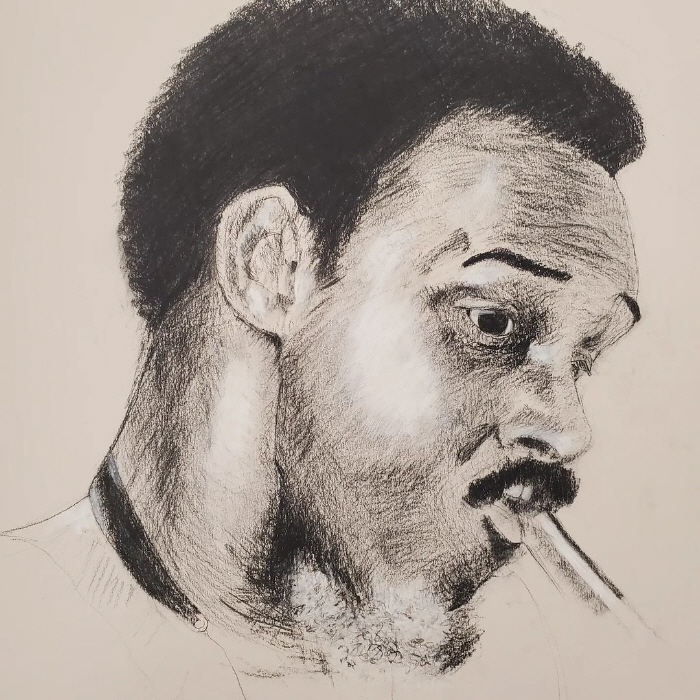 |
|||||||||||||||||||||||||||||||||||||||||||||||
|
“- coloured shapes come from bballchico. |
|||||||||||||||||||||||||||||||||||||||||||||||
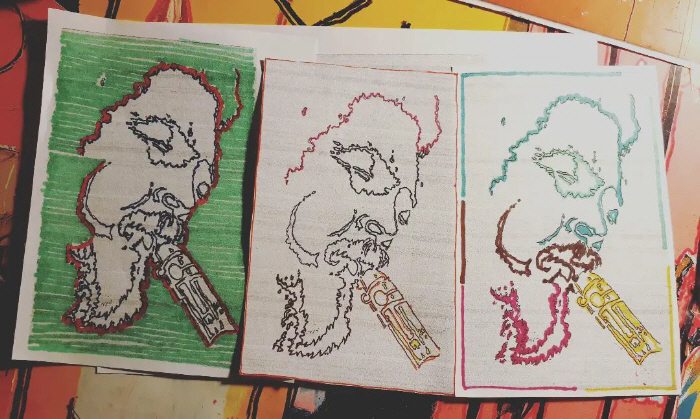 |
|||||||||||||||||||||||||||||||||||||||||||||||
|
“- and a poster is sold by whiteRabbitLemgo.” |
|||||||||||||||||||||||||||||||||||||||||||||||
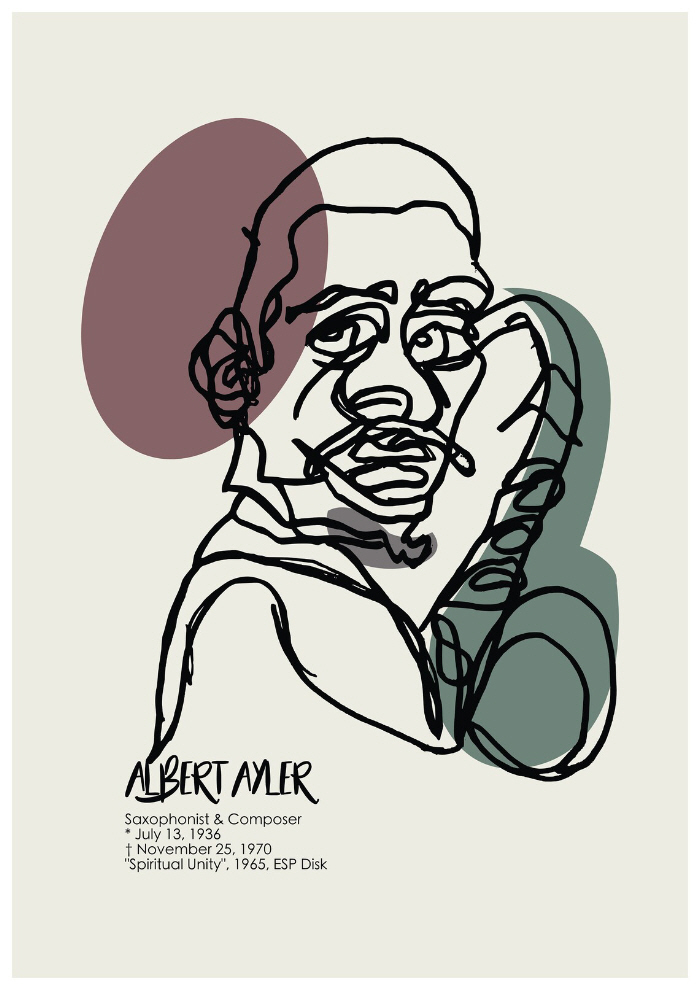 |
|||||||||||||||||||||||||||||||||||||||||||||||
|
and a couple of ‘videos’ “- ColossusTheKid's "Foreword (Albert Ayler)" uses "Message from Albert". It's the opener of his album "Tale From The Izanami (The Mixtape)". and “- A cadenza comes from Italy. ""Microburst" for tenor saxophone and devices_2.Cadenza I, to Albert Ayler" is by David Brutti (or Michele Sanna, I’m not sure).” I reckon the piece is composed by Michele Sanna and is played by saxophonist David Brutti. There is a third ‘video’, but we’ll leave that one till the end. * youtube roundup All I can bring to the party are a few more videos. This first one is from Alexander Dannullis, to which he appends the following remarks: ‘Gratitude for Albert Ayler One of my all-time favourites: Albert Ayler (1936-1970), wonderful tenor saxophonist. I love him. With the close studying of Albert Ayler's music (which needed some effort) I eventually felt encouraged to play what needed to be expressed. It became an inner urge and everything I play is guided by that desire. To gave shape to the really important things, the expressive things can be an obsession.. Expression can be focussed sonically - by taking advantage of all the possibilities an instrument can create. But of greater importance: Expression is THE challenge - to reveal what's in your soul. All the experiences that happened to you, especially those from the very first years of existence, that you forced to feel and that could not be denied. And this of course is a lifetime-goal: once you were given to feel the beauty of creating from deep within you never want to miss it. It gives life to all the creations and it's inspiring. And - you want to share it, let people take part of what's happening inside of you. This piece is an example for that approach: You never know whether you 'managed it', but you are willing to give and the process feels more like a sacrifice, than just creating notes. I played electric guitar in this improvised piece of music and what you hear are sounds of investigation - frequently beyond the ordinary and known guitar-sounds. Not only Albert Ayler may come to mind - one might detect the influence of Giacinto Scelsi as well - another great pioneer of the sonic realm and adventure.
|
|||||||||||||||||||||||||||||||||||||||||||||||
|
Next up is ‘Love Cry’ performed by students from the CCPA Music Conservatory at Roosevelt University. The full concert of CCPA Blues and Avant-Garde Combos is also available.
|
|||||||||||||||||||||||||||||||||||||||||||||||
|
There’s an episode of the Bottomless Pit podcast concerning the ESP label - there’s one selection from Spiritual Unity, but most of the music is from the rock end of the spectrum - much Fugs. A couple of videos from Dean Westerfield, including the finale of his graphic novel about Albert Ayler, and a quick stroll through same. A lecture on noise. And - this is a rather convoluted one - a discussion, in German, about ... ‘The composer Sidney Corbett and Sabine Bergk talk about the struggle for sound, listening in your inner ear before something can be written or decided - in search of a clarity that you can only ever approach. The poem set to music comes from the poet Sadiq Bey, who lives in Detroit and Berlin. His poems tell Janus-faced stories about childlike angelic apparitions, about the visionary saxophonist Albert Ayler and extend all the way to the Görlitz mystic Jakob Böhme.’ The piece they are discussing, Evening’s Search for Beauty is a poem by Sadiq Bey, set to music by Sidney Corbett for baritone and piano. The SheetMusicPlus site has the following description of the piece: ‘Evening's Search for Beauty I met Sadiq Bey at an exhibition of art works by my friend, the artist Detlev Gunther in a gallery in Berlin sometime in 2015 or 2016. We both soon discovered we had roots in Detroit, where he was born, as was my father. We spoke about art, culture, politics and the great civil rights activist Rosa Parks, whom he had known personally. He gave me his book of poetry, "Albert Ayler is blowing the horn that announces the end". Albert Ayler is one of my personal heroes, one of the truly great and individual jazz musicians of his era. In reading the poems I immediately realized that the words and lines were calling music to my inner ear. So I thought I would ask for permission to set some of the poems to music. The baritone Holger Falk had asked me for some songs and somehow this seemed a good match. It was more easily thought than accomplished however, because Sadiq is also a musician and the idea that someone else would write music to his poetry was a completely foreign concept, so he first asked me to send him some music and then after some consideration said he didn't think it was such a good idea.... Then, a bit later he contacted me again and said he was sorry for being so protective and that I should feel free, if I were still interested. Of course I was and this cycle is the result of my wrestling with his lines. Sadiq's poetry traverses a wide range of topics, as does all good poetry. My inner eye, and ear, were attracted by his writings on the great Protestant mystic Jakob Boehme on the one hand and on short poems which describe intimate moments that at least to me seem related to the instances of divine knowledge central to Boehme's thought. And of course the invocation of Albert Ayler. The cycle is dedicated to my friend, the baritone Holger Falk, who premiered them together with the pianist (and composer) Steffen Schleiermacher, in Stuttgart at the Hugo Wolf Gesellschaft in July 2017.' The piece is played towards the end of the youtube discussion around the 24:12 mark. * And finally . . . As promised, and against my better judgement: Albert Ayler & Monkey. ***
June 1 2024
Another Reissue From Hat Hut This is a surprise. Last July I bade farewell to Hat Hut’s series of ‘Revisited’ Ayler albums, which I thought had ended with More Lost Performances, but here’s another one. This entry in the series is the final appearance of the Ayler brothers together, both live In Greenwich Village and in the studio with Love Cry. The CD is not due for release until the 28th of this month so there’ll be more information in the next update. |
|||||||||||||||||||||||||||||||||||||||||||||||
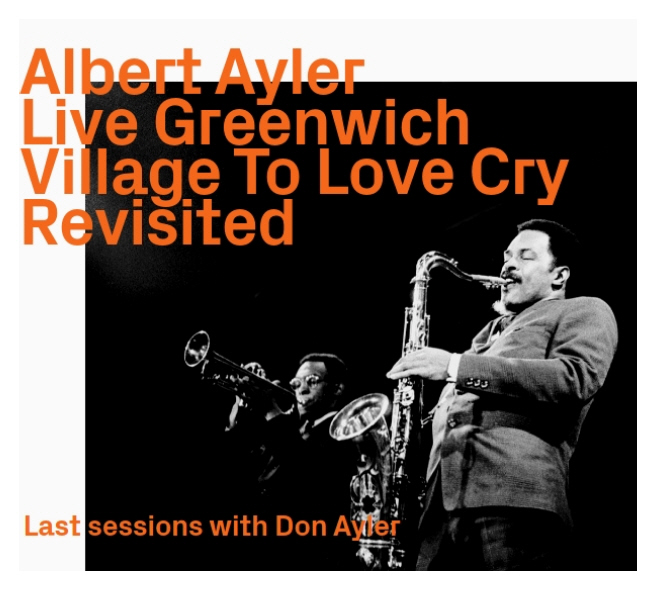 |
|||||||||||||||||||||||||||||||||||||||||||||||
|
The King In Yellow Dirk Goedeking spotted the above item, and he also sent me a selection of yellow things. The yellow-coloured album by Wadada Leo Smith and Amina Claudine Myers, Central Park’s Mosaic of Reservoir, Lake, Paths and Gardens, which you’ll find mentioned at the bottom of this page, has been released. There are reviews at Pitchfork and The Guardian, the album is available on bandcamp, and track 6, entitled ‘Albert Ayler - A Meditation In Light’, is on youtube.
|
|||||||||||||||||||||||||||||||||||||||||||||||
|
And there are more mentions of Love Cry: “At last Albert Ayler got his statue! Neither in Cleveland nor in New York, but ... a tiny statuette, made by somebody who likes the Love Cry cover. |
|||||||||||||||||||||||||||||||||||||||||||||||
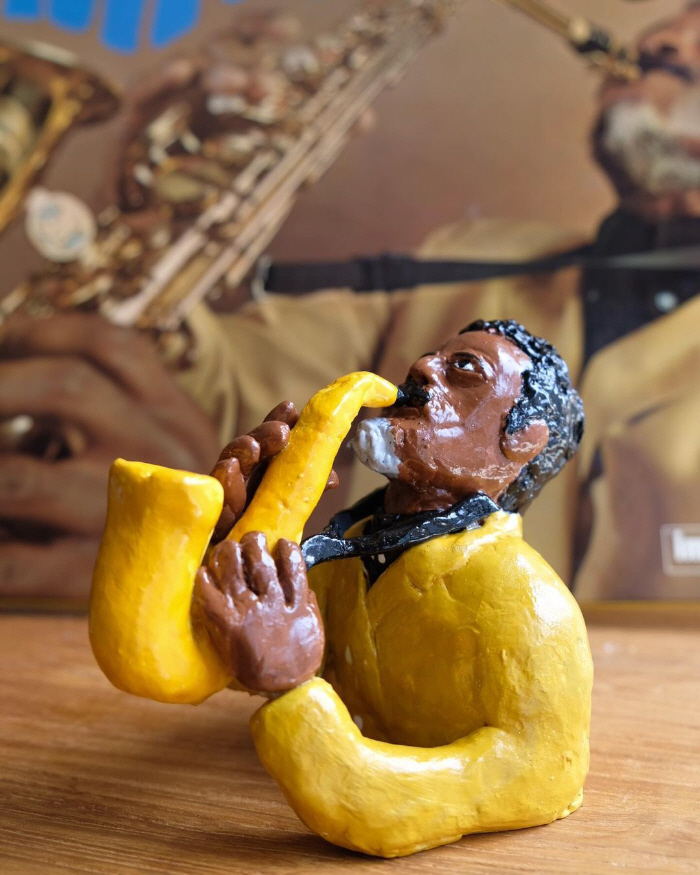 |
|||||||||||||||||||||||||||||||||||||||||||||||
|
“By the way, the record's yellow pressing has a yellow Sun Ra twin. |
|||||||||||||||||||||||||||||||||||||||||||||||
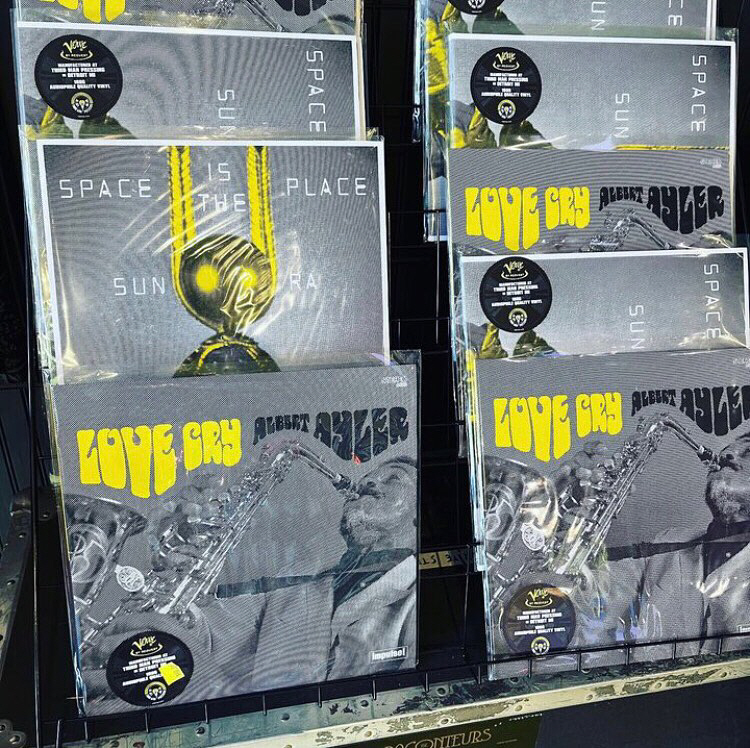 |
|||||||||||||||||||||||||||||||||||||||||||||||
|
“and there's a yellow "Love Cry" shirt.” |
|||||||||||||||||||||||||||||||||||||||||||||||
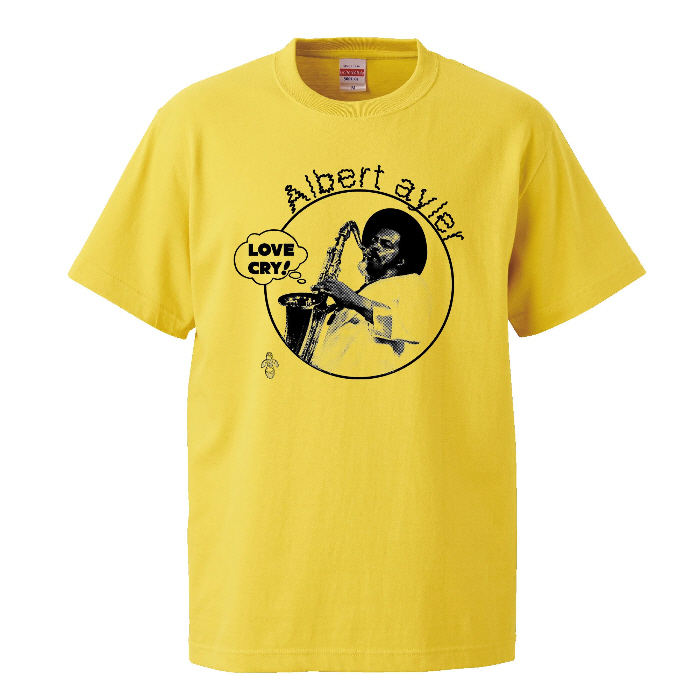 |
|||||||||||||||||||||||||||||||||||||||||||||||
|
and more ... Dirk also came across this piece from Amiri Baraka’s 2009 book Digging: The Afro-American Soul of American Classical Music: |
|||||||||||||||||||||||||||||||||||||||||||||||
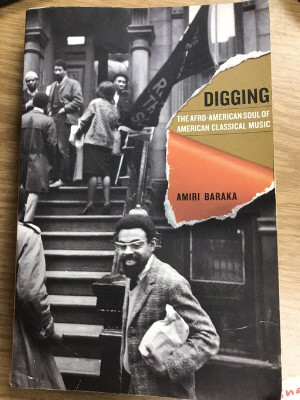 |
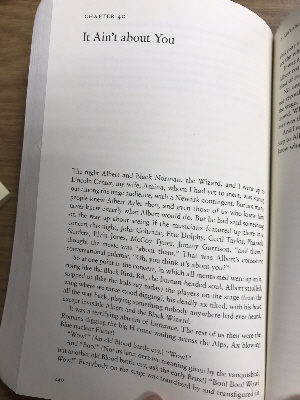 |
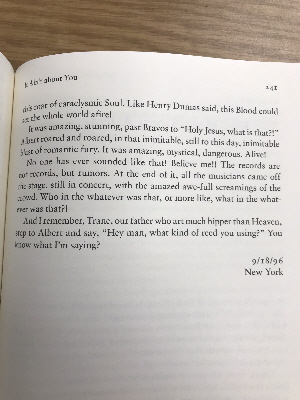 |
|||||||||||||||||||||||||||||||||||||||||||||
|
Which rang a distant bell. A slightly different version formed part of Amiri’s Baraka’s contribution to the book included in Revenant’s Holy Ghost box set of 2004. |
|||||||||||||||||||||||||||||||||||||||||||||||
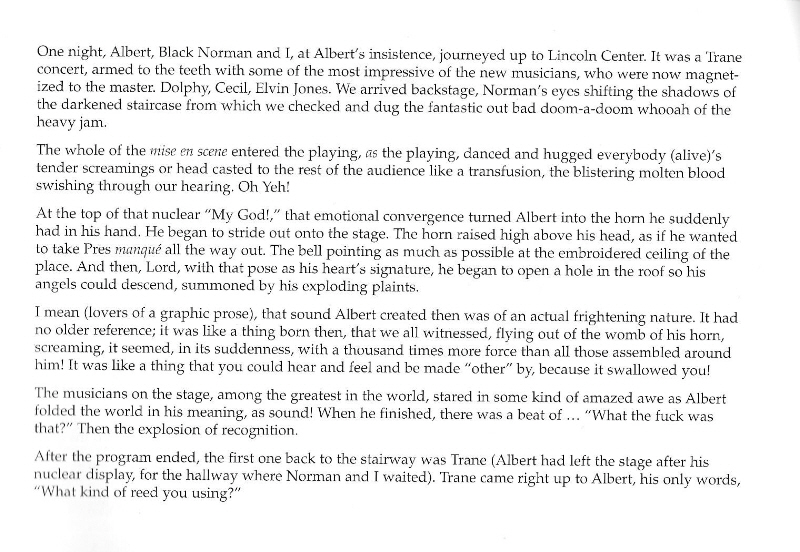 |
|||||||||||||||||||||||||||||||||||||||||||||||
|
In April I mentioned the Albert Ayler Tribute Unit from Japan. Dirk tracked down a couple of photos of the band, so I will have to add them to the Tributes pages. |
|||||||||||||||||||||||||||||||||||||||||||||||
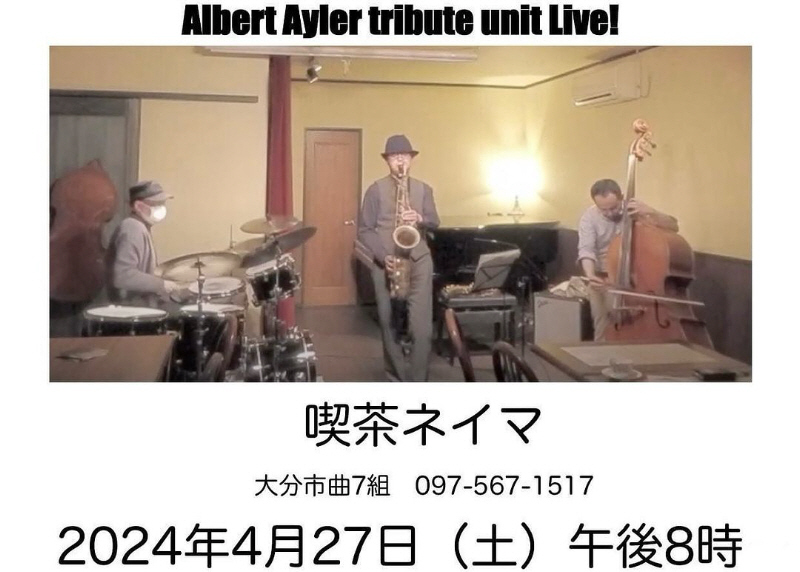 |
|||||||||||||||||||||||||||||||||||||||||||||||
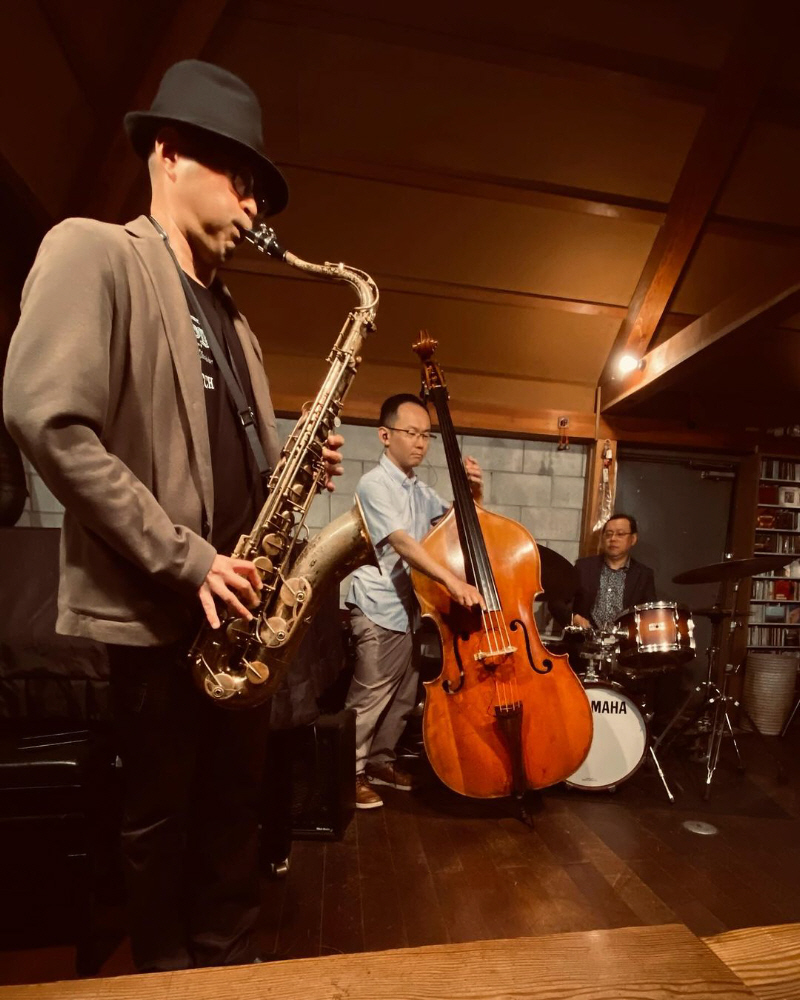 |
|||||||||||||||||||||||||||||||||||||||||||||||
|
And finally from Dirk is a link to some photos of Richard Williams’ reviews in the Melody Maker, which is a bit annoying since one of them is for The Village Concerts. I was hoping The World Radio History site might have a copy, but their Melody Maker files aren’t complete, so I’ll have to keep an eye out for it. This is all I can make out at the moment: Melody Maker (9 September, 1978 - p.28) The beauty of Ayler ALBERT AYLER: “The Village Concerts”. (a) Light In Darkness;, Heavenly Home; Spiritual Rebirth; Infinite Spirit; Omega Is The Alpha; (b) Spirits Rejoice; Divine Peacemaker, (c) Angels. (Impulse IA-9336/2 two LPs, US Import.) THE paucity of Albert Ayler’s recorded legacy has almost certainly been a factor in the size of his reputation, which is disproportionately small when compared with the scope of his influence over virtually the entire field of free improvisation.
The photo is below, alongside another review of a tribute album to Albert Ayler from John Stevens’ S.M.E. |
|||||||||||||||||||||||||||||||||||||||||||||||
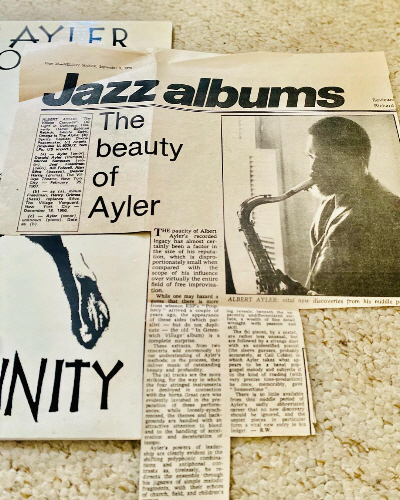 |
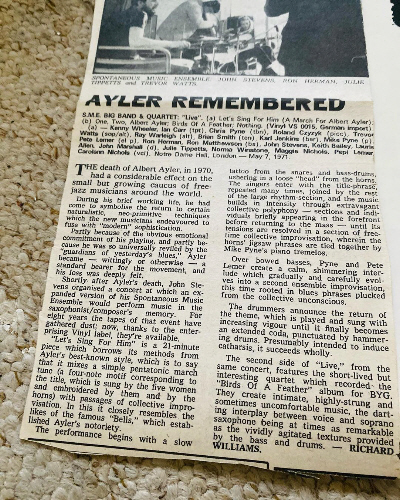 |
||||||||||||||||||||||||||||||||||||||||||||||
|
Last year (February to be exact) I included a piece from Lee Santa about his meeting Albert Ayler at Carnegie Hall. It was extracted from a rough draft for a memoir that Lee was writing. Lee has now sent me a revised copy of the occasion, along with another extract concerning Sunny Murray. I’ve placed this ‘new’ version on the Ayler Remembered page. Lee says that his book is “on the back burner for now”, but he does have another project in the pipeline. Several of his photos are going to be used in an American Masters (PBS) documentary about Sun Ra, which is due to air in autumn 2025. * Zoh Amba is a name which keeps cropping up whenever I do my monthly google search for news about Albert Ayler. Every review of Zoh Amba seems to include a comparison with Ayler. So far I’ve ignored such things but there is an article by Geoff Dyer on The Guardian site, which, as well as going into raptures about Ms. Amba, also makes more of her apparent links to Mr. Ayler than usual. It’s headlined “’Scalding emotional intensity’: Geoff Dyer on the spiritual power of saxophonist Zoh Amba” and the subheading reads “Still only 23, the US saxophonist is channelling the free jazz pioneered by Albert Ayler in the 60s—and making hugely profound, wildly uplifting music .” * A couple of lists and a youtube roundup The Brooklyn Vegan has Alan Braufman’s list of influential albums, which includes Spiritual Unity. And there’s a list on youtube of ‘Famous People Who Died Of Drowning’, which includes Albert (as well as Eric Fleming - rollin’ rollin’ rollin’ though the streams are swollen’). Youtube also has a review of the Europe ‘66 vinyl box set by Doctor Robert. and finally, this month’s version of ‘Ghosts’ by the CALM. Quartet.
|
|||||||||||||||||||||||||||||||||||||||||||||||
|
*** News from 2004 (January - June) 2004 (July - December) 2005 (January - May) 2005 (June - December) 2010 (January - June) 2010 (July - December) 2011 (January - May) 2011 (June - September) 2011 (October - December) 2012 (January - May) 2012 (June - December) 2013 (January - June) 2013 (July - September) 2013 (October - December) 2014 (January - June) 2014 (July - December) 2015 (January - May) 2015 (June - August) 2015 (September - December) 2016 (January - March) 2016 (April - June) 2016 (July - August) 2016 (September - December) 2017 (January - May) 2017 (June - September) 2017 (October - December) 2018 (January - May) 2018 (June - September) 2018 (October - December) 2019 (January - May) 2019 (June - September) 2019 (October - December) 2020 (January - April) 2020 (May - August) 2020 (September - December) 2021 (January - March) 2021 (April - July) 2021 (August - December) 2022 (January - April) 2022 (May - August) 2022 (September - December) 2023 (January - March) 2023 (April - June) 2023 (July - September) 2023 (October - December) 2024 (January - March) 2024 (July - September) 2024 (October - December) 2025 (January - March)
|
|||||||||||||||||||||||||||||||||||||||||||||||
|
Home Biography Discography The Music Archives Links What’s New Site Search
|
